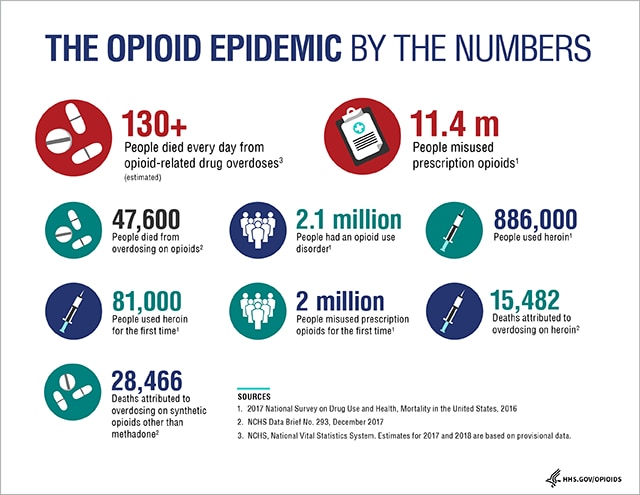A drug manufacturer denounces his own industry and explains to 60 Minutes how a label change by the FDA expanded the use of opioids. Bill Whitaker reports. Air Date: Feb 24, 2019 Watch the video.
About our Blog...
On Stay Safe Rx you will find current events and resources advocating for safe prescription labeling practices. When patients struggle to see, read or understand their prescription labels they are more likely to take the wrong medication, take it improperly, or not take it at all. Pharmacies can make prescription labels more accessible by incorporating dual-language, audible, large print, Braille, plain language, and user-friendly designs. Check out the resources in the side bar to assist your own advocacy efforts or browse through posts to see what others are working on or have achieved.
Timeline of the Opioid Crisis
(Source: CNN)
The opioid epidemic has roots that date back to the 1800s when Heroin was believed to be less addictive than morphine. CNN created timeline of how the United States got to where it is today. Go to the Timeline
Real Solutions-How One Small Town in Minnesota Beat the Opioid Crisis
Town
halls and committees all over the country are looking for ways to
combat the opioid epidemic. Many are turning to the places that have
succeeded in making a noticeable difference in their community.
Little Falls, Minnesota, didn’t do anything revolutionary. They just made a real effort, and spent real money, treating addiction as a disease, not a crime.
Read more about what worked for them.
Little Falls, Minnesota, didn’t do anything revolutionary. They just made a real effort, and spent real money, treating addiction as a disease, not a crime.
Read more about what worked for them.
What is the US Opioid Epidemic?
- In the late 1990's, pharmaceutical companies reassured the medical community that patients would not become addicted to opioid pain relievers and healthcare providers began to prescribe them at greater rates.
- Increased prescription of opioid medications led to widespread misuse of both prescription and non-prescription opioids before it became clear that these medications could indeed be highly addictive.
- In 2017 HHS declared a public health emergency and announced a 5-Point Strategy To Combat the Opioid Crisis
- Visit the Department of Health and Human Services web page on the opiod epidemic for more information and statistics.

Download the Opioid Epidemic in the U.S. The Opioids By The Numbers” graphic and PDF are currently undergoing 508 review. Assistive technology users should email 508helpdesk@hhs.gov.
Controlled Substance Safety Labels: A Pharmacy Solution to Help Combat Opioid Addiction
More than half of patients lack confidence in their ability to properly
take new medications as directed, according to a new
survey. When patients answered how they would like to learn about new medications, written materials came in dead last.
“Rather than rely on written handouts from doctors and pharmacists, we
must take advantage of technologies like smartphones and patient portals to
deliver impactful, customized details about prescribed medications,” says
Cameron Deemer, president of the company that completed the survey.
Videos would be one avenue. Physicians and pharmacists are short on
time, so a safety video, especially when it comes to controlled substances,
could make a huge difference in adherence and patient safety.
New to the market is a pharmacy label option: Controlled Substance
Safety Label (CSSL). This auxiliary label distinguishes a Schedule II
medication, calling attention to the addictive nature and risk for overdose,
and reinforcing the need for caution when taking the drug.
 |
| Try it now: scan the QR code to play safety video |
A CSSL features a QR code which, when scanned, plays a brief safety
video, detailing a drug’s instructions, side effects and warnings in an easy-to-understand
audio and visual format.
Anyone, no matter their level of reading comprehension or sensory
input, would benefit from a CSSL label when prescribed a dangerous drug.
CSSLs are available across the US and Canada at participating
pharmacies by request.
Safe Medication Management: Ensuring Effective Communication and Accessibility for Individuals with Disabilities
 If a person with a visual or print impairment struggles to read a prescription label, it’s time for the pharmacy to take action. Accessible prescription labels have been available since 2003 and are options that any pharmacy can implement. Formats include large print labels, Braille labels, and talking labels and prescription readers. Controlled Substance Safety Labels (CSSLs) are the latest addition to the options that keep patients safe. The National Council on Disability features a guide to help pharmacists with providing labeling accommodations: Best Practices for Prescription Drug Labeling
If a person with a visual or print impairment struggles to read a prescription label, it’s time for the pharmacy to take action. Accessible prescription labels have been available since 2003 and are options that any pharmacy can implement. Formats include large print labels, Braille labels, and talking labels and prescription readers. Controlled Substance Safety Labels (CSSLs) are the latest addition to the options that keep patients safe. The National Council on Disability features a guide to help pharmacists with providing labeling accommodations: Best Practices for Prescription Drug Labeling A person has a right to reasonable accommodation to equal access, including the critical information on a prescription label. Not being able to read a prescription label can lead to medication errors, a trip to the ER, or worse. Anyone denied access to information can file a complaint with Health and Human Services or their state’s board of pharmacy and cite the protection laws discussed below.
Subscribe to:
Posts (Atom)


